How Grandpa Chron Influenced My Life – Clint Chron
by Clint Chron (grandson of Virgil Chron)
Prior to 1957, we lived in Ralls, Texas. Dad got me interested in electronics at early age. As a Cub Scout in 1955, I had a project to build a crystal radio set. The nearest radio station was in Lubbock – 28 miles away. The radio set was very simple, but we could not get it to work. It looked something like this:

I had to cut out the wood mounting block, wind the coil on a cardboard toilet paper roll, etc.
We had no contacts that could help us with the electronics. However, I had a friend – John Cornwell. His dad was J L Cornwell. Grandpa Chron had told me that J L was a ham radio operator and he talked with hams all over the world. When we drove by his house, Granda pointed out his ham shack in the back yard and all of the wire antennas that were strung from towers. For some reason, Grandpa never hooked me up with J L and I never asked John about ham radio.
A short time later, Dad bought me a $4 Remco crystal radio kit. It was no different than the previous kit that did not work – but this one worked. Dad strung a long wire antenna from one end of the house down to the window in my bedroom. I could actually hear the Lubbock radio station.
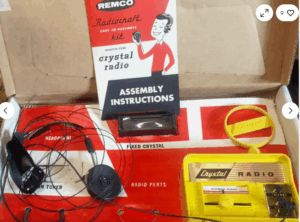
Little did I know that I was on my way to becoming a ham radio operator.
In 1957, Dad told Grandpa that we were moving to Alaska. Grandpa was not a happy camper. He knew that he would not be seeing us again for a long time and that long distance telephone calls were very expensive. I did not realize it as the time, but he knew more about J L Cornwell’s ham radio operation than what he had shared with me. He knew that ham radio operators could connect people in town, via their telephones, to the ham radio system. Through the ham radios, they could talk with people anywhere in the country. Grandpa told me that if I got my ham radio license, he would buy me a ham radio setup. I was not sure what that meant, but I figured I could get my license. Grandpa figured that J L could talk with a ham in Anchorage Alaska. The Anchorage ham would call us on the telephone and J L would call Grandpa on the phone. The ham radio equipment would allow us to talk with Grandpa and Grandma without any long distance telephone charges.
We made the move to Alaska. I had no idea on how to get started in ham radio, but I knew that I had to get my license. Someone at church gave Dad a Heathkit AT-1 transmitter. I could not use it since I had no license, no receiver, no antenna, and the transmitter was for code only – no voice operation.
The AT-1 was the first ham radio transmitter that Heathkit introduced (back in about 1953).
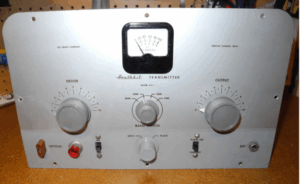
I still knew no hams and Dad never introduced me to the guy that gave him the transmitter.
A new kid moved in across the street. We became friends – his Dad worked for the FAA. He showed me a Hallicrafters short wave receiver that his Dad had in their basement. We would spend hours tuning across the shortwave bands, listening to foreign radio stations, pilots in airplanes, hams, etc. That opened up a whole new world for me, but I still did not know what it was going to take to get my ham license.
In the spring of 1959, we were making plans to move from Anchorage to Eagle River. Dad was the pastor of the First Baptist Church of Eagle River. I was playing outside my house and a girl from school stopped by. We started talking. I knew her older brother – Ross. We started talking about ham radio and she told me that Ross and her Dad were ham radio operators. I was very excited. Maybe I could meet them. She got back with me and told me to come over one night. I went over and met her Dad. He showed me his ham radio equipment. Ross also had he own ham radio system in his bedroom. We talked about getting my ham license. Al told me that I needed to learn Morse code. To do that, I needed a Morse code oscillator with a telegraph key. I did not have that. Al said that Ross and he would build me a morse code oscillator, but I would have to buy some parts, including a telegraph key. School was out and I bicycled from Turnagain all the way to downtown Anchorage, to the local ham store. That took me 30 minutes each way. For $5, I bought a telegraph key, a headphone set, and an Ameco ham radio license book.
I went back over to Al’s house a couple of nights. He and Ross were building a one tube code practice oscillator. They could not get it to work. We moved to Eagle River in June and I figured that I would never hear from Al and Ross again. I had no way to practice sending Morse code. The ham license book told me that I would need to start with my Novice license. I had to be able to demonstrate that I could send and receive Morse code at 5 words per minute. I also had to pass a 20 question multiple choice written test. After I got my Novice license, I could use Morse code on several ham bands, but could not talk with anyone. The Novice license was good for one year and was not renewable. After one year, I would have to get my General license. With that license, I could talk with other hams. That would allow me to talk with the ham back in Ralls so that he could connect his ham radio equipment to Grandpa’s telephone at the farm, through a box called a “phone patch” (In 1961, Grandpa Chron introduced me to another ham that lived in Ralls – Kendall Young).
I also started studying the Ameco ham license book. It was full on rules/regulations and electronic theory on vacuum tubes (transistors were not generally in use).
Around the end of June, on a Saturday, Al and Ross drive up in a Jeep. I was total surprised. They told me that they never could get the tube code practice oscillator working, so they built me a one transistor code practice oscillator. It ran on two D cell batteries, so I could use it anywhere. I was overjoyed. I could now learn Morse code and get my Novice license.
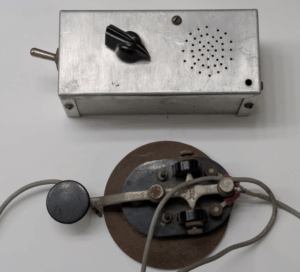
I told Grandpa about my progress and he said he would start looking for a ham radio station for me. I quickly found that the headphones, that plugged into the code practice oscillator, were not comfortable to wear for hours at a time. The batteries did not last very long before they needed to be replaced. In the winter of 59, V Allen (my uncle) flew up to Anchorage to preach a revival at one of the Baptist churches. Grandpa had purchased a ham radio station setup for $300 (that would be at least $3000 today). V Allen carried the Hallicrafters receiver under his arm on the airplane. When a stewardess asked him what he was carrying he said “a bomb”. They all had a good laugh.
The receiver was high end for the day. I wish that I had gotten details from Grandpa about who owned the equipment, why he got rid of it, etc. The receiver was only a couple of years old and cost $250 when new.
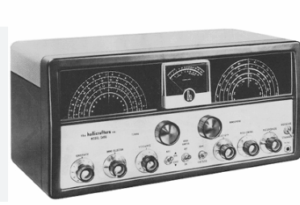
I strung up a wire antenna in the back yard and started listening to short wave stations, code stations, etc. I was in hog heaven.
I worked on my code receiving/sending skills every day of the week, along with studying for my Novice test.
In the summer of 1960, V Allen and his family moved to Anchorage. In his moving van, he brought me a Heathkit DX-100 transmitter. That was a high end transmitter and it sold for $190 in kit form. My DX-100 had already been assembled. I could use that transmitter with my Novice license and also my General license.
The transmitter was huge – it weighed 100 pounds.
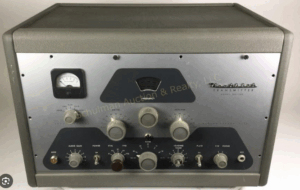
By the end of the summer in 1960, I felt I was ready to take the Novice test. I could not take the test in the Anchorage FCC office. I had to go down to the office, sign out for the test package, and find a General class (or higher) ham to administer the test and confirm that I could send and receive Morse code at 5 words per minute. I did not know any hams in Eagle River, but I remembered seeing a big ham radio antenna at a house out in the Chugiak woods. Dad and I drove to the house one evening – no one home. We drove to the house several times over the next few weeks. Still no one home. I had to bring the FCC test envelope back to the FCC office within two weeks. Finally, we drove to the house and a guy answered the door. I explained what I was trying to do. He said, sorry, I cannot help you.
So I had to take the test envelope back to the FCC office and sign it out for another two weeks. I am not sure why I never contacted Al in Anchorage to give me the test. I remembered that there was a girl in my 7th grade class whose Dad was a ham. So we drove over to her house one evening. They were in the process of packing and moving back to the south 48th. He had no ham equipment in his house – it was all packed up. I had brough along my code practice oscillator. I took one earpiece off the headset and held it against my ear. Elien’s Dad took the other earpiece and held it against his ear. I passed the code test and then took the written exam. Took the test envelope back to the FCC office. They said I would get my Novice ham license in about two weeks if I passed the test. Two weeks later, I got my FCC license in the mail – WL7DQP. Now I had to get my ham station on the air.
I had strung a wire antenna from a tall birch tree in our back yard to the peak of our house and ran the feed line down into my bedroom. I was ready to make code contacts. Each night, I would call a number of stations that I heard, but never got a reply. I did not know what to do. Little did I know that my wire antenna was OK for receiving, but would not work for transmitting. I figured I needed a better antenna. I went to the ham store in Anchorage and purchased a HyGain 14AVS vertical antenna for $50. I installed the antenna on the top of our house. Success – I called CQ and got a response from a ham in state of Washington. I was on my way into the ham radio work. That same antenna was selling for about $450 last year.
With my Novice license, I could not talk through ham radio to my Granda in Texas. We moved back to Texas in December of 1960. I had to get a new ham radio call sign since I had moved out of Alaska. My new call sign was KN5HGH. The “N” meant that I had a Novice license. I started studying for my General class license. The General class license test had to be taken in a FCC office. The closest FCC office was in Dallas – 350 miles away. The Conditional test could be administered by a General Class ham. I had to be able to send/receive Morse code at 13 words per minute and take a 50 question written test. The Conditional license had the same privileges as the General Class. I was ready to take the test in the summer of 1961. A ham friend in Plainview administered the test (we had lived in Plainview from January to July of 1961). I passed the test and my ham call sign became K5HGF. I got my ham station setup in our Abernathy house. I could now use voice to communicate with other hams – but did not need to phone patch to talk with Grandpa. A telephone call from Abernathy to Ralls was pretty cheap.
In any event, I had a good foundation for my ham radio adventures in the years to come.
I got some QSL cards printed. When I had made a contact with another ham, I would send them a QSL card to confirm the contact. They would also send me one of their cards. I think that I kept Dad broke with buying 6 cent stamps for the QSL cards.
This picture was from around 1962, showing my Hallicrafters receiver and HealthKit transmitter that Grandpa Chron had purchased for me. I was 14 years old.
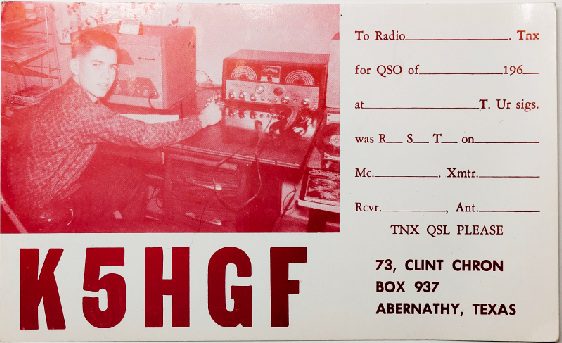
Little did Grandpa Chron know the impact he would have on my life 68 years later.
I never did directly reach the goal of talking from Alaska to Texas via a ham radio phone patch. However, in the early 70s, I was stationed aboard a nuclear submarine in Pearl Harbor, Hawaii. Janet lived in Anchorage and it was still very expensive to talk on the phone from Hawaii to anywhere else in the USA. I operated the sub base ham station (KH6SP) when I was in port. I would have hams in Anchorage run phone patches to Janet. I also had hams in Lubbock run phone patches to Grandpa Chron in Ralls.
And yes, I still have my ham radio license (W7KEC) and I still talk with hams from time to time on my ham radio station.
